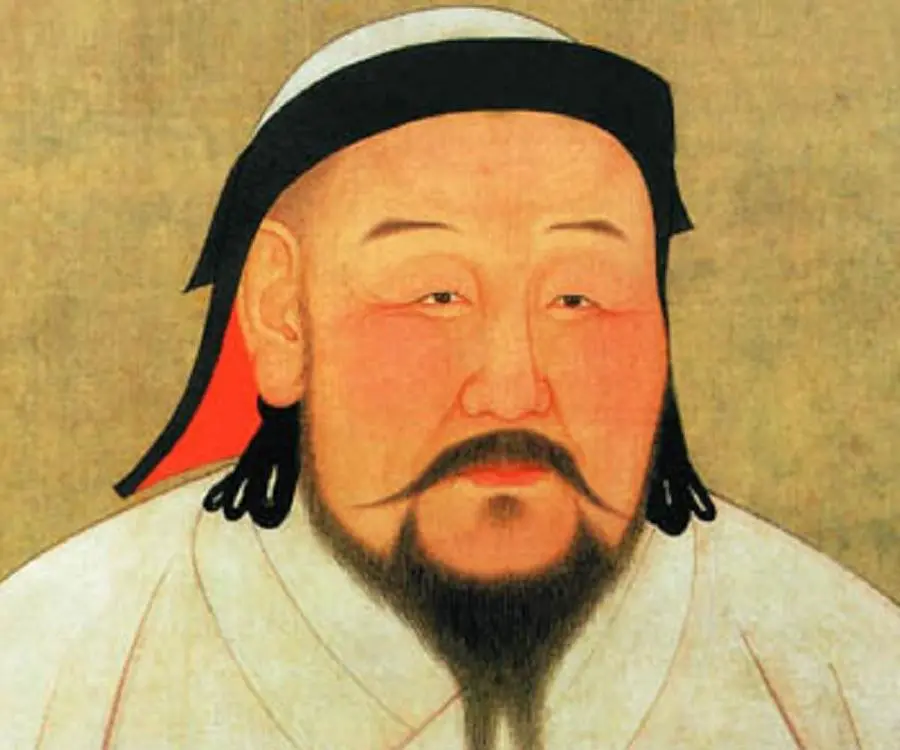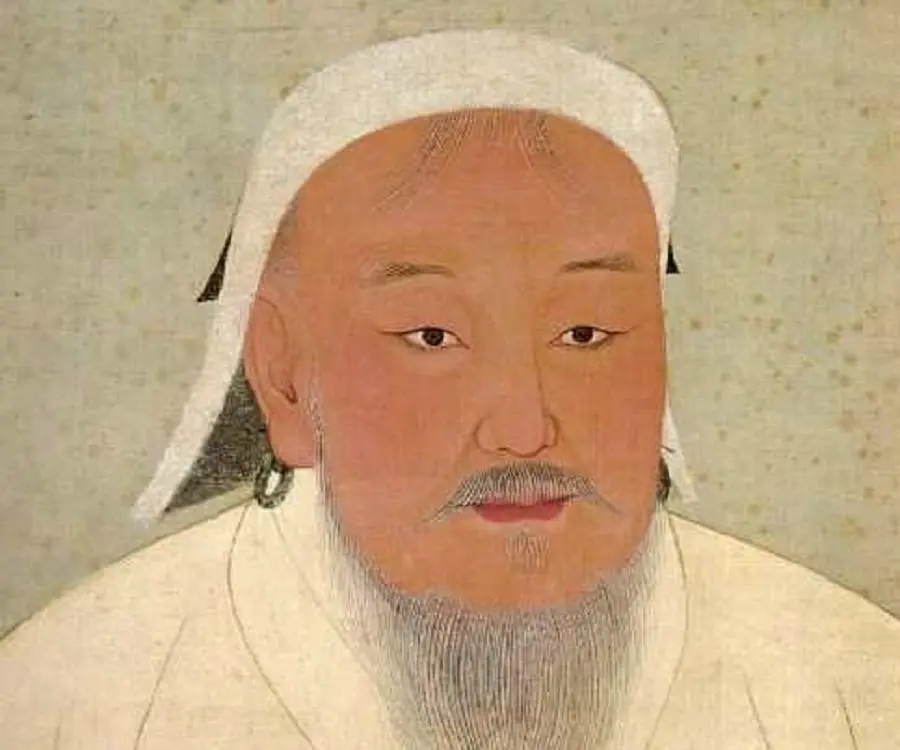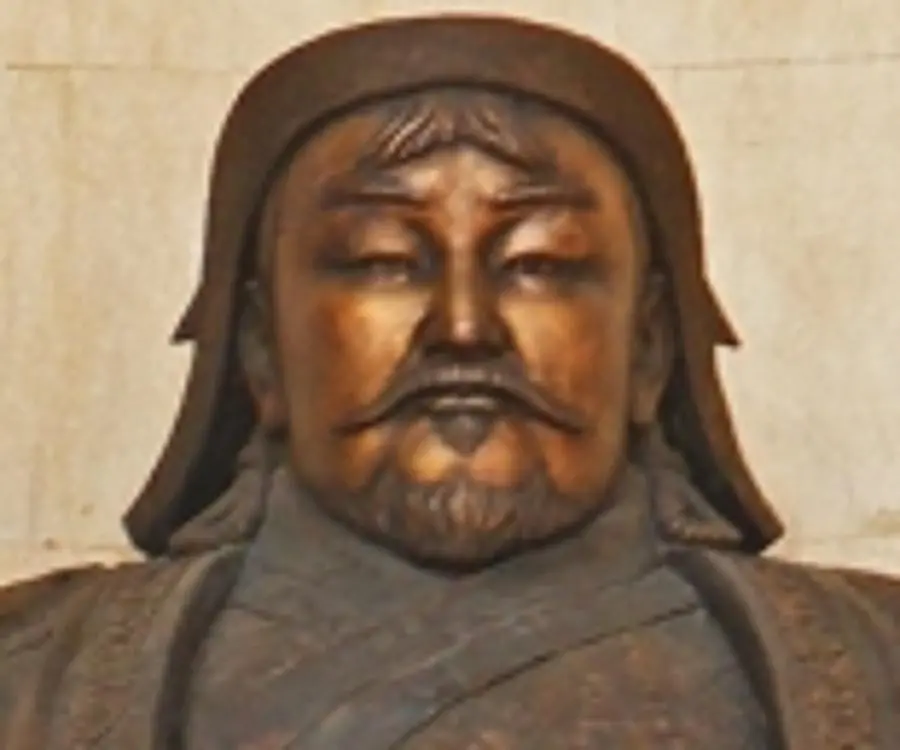
Genghis Khan - Emperors, Facts and Personal Life
Genghis Khan's Personal Details
Genghis Khan is the one of the most famous emperors in history, who founded the Mongol empire
| Information | Detail |
|---|---|
| Birthday | 1162 |
| Died on | August 18, 1227 |
| Nationality | Mongolian |
| Famous | Historical Personalities, Emperors & Kings, Military Leaders, Emperors, Khagan of the Mongol Empire, Kings |
| Spouses | Börte, Khulan khatun, Yesugen, Yesui |
| Siblings | Belgutei, Hachiun, Qasar, Temüge, Temulin |
| Childrens | Alakhai Bekhi, Alaltun, Chagatai Khan, Checheikhen, Gelejian, Jochi Khan, Khochen Beki, Ögedei Khan, Tolui, Tümelün |
| Founder / Co-Founder |
|
| Birth Place | Delüün Boldog |
| Gender | Male |
| Father | Yesügei |
| Mother | Hoelun |
| Born in | Delüün Boldog |
| Famous as | Khagan of the Mongol Empire |
| Died at Age | 65 |
Genghis Khan's photo
Who is Genghis Khan?
Genghis Khan was the legendary political leader, who is famous even today for having established the powerful Mongol dynasty. Having faced destitution at a very tender age, he grew up with a hunger for power and respect. Since his father died when he was but a small boy, his mother taught him everything about Mongolian politics, where no tribe was on good terms with the other. The young man gradually began his conquests, and was eventually successful in bringing all powerful tribes under one umbrella. He is known to this day for his religious tolerance and general protective demeanour. This famous ruler is the symbol of patriotism in Mongolia, and his name and face is used on every product in the country, to help it sell. Though he is still a popular figure in the nation he laid the foundation of, in countries like China, people hold mixed sentiments about the leader. While his empire, which was later called the 'Yuan dynasty', helped bring together most of China, his conquests also caused the death of many people. In other parts of the world like the Middle East, this ruler is still abhorred, for having destroyed so many lives. However, whatever sentiments people hold, this leader still remains one of the most important figures in the history of Mongolia, and the world
// Famous Emperors
Sundiata Keita
Sundiata Keita was the founder of the Mali Empire in West Africa. This biography profiles his childhood, early life, struggles, founding of empire, rule, administration, achievements and also gives some fun facts.
Ashoka
Ashoka was the third emperor of the Mauryan Dynasty and ruled almost the entire Indian subcontinent. This biography profiles his childhood, life, reign, achievements and timeline
Murad IV
Murad IV was one of the mighty Sultans in the history of the Ottoman Empire. This biography profiles his childhood, family, accession, rule, administration and timeline.
Childhood & Early Life
Genghis Khan was born as Temujin, to Yesügei, the leader of the Khamag Mongol tribe, and his wife, Hoelun, in Delüün Boldog, present day Mongolia. Though the exact date of his birth is unknown, it is estimated that he was born in the latter half of the twelfth century.
Temujin lived with his parents, as well as his siblings Hasar, Hachiun, Temüge, Begter, Temülen, and Belgutei. While Hasar, Temüge, Temülen, and Hachiun, were his own siblings, Begter and Belgutei were half-brothers.
After Yesügei was betrayed and killed by representatives of the 'Tatar' tribe, Temujin wanted to become the chief. However, he was rejected because he was very young, and the whole family was left to fend for themselves. For a long time the family lived in dire poverty, foraging for food all by themselves.
During this time, Mongolian tribes were not united, and the only way of forming allies was by fixing marriages between children of individual rulers.
Accession & Reign
Temüjin initially became a close associate to his father’s blood brother, Toghrul, the ruler of the 'Khereid' tribe. Soon, the former began rising to power, and his greatest opposition came from his childhood friend, political leader of the 'Jadaran' tribe, Jamukha.
In 1186, Temüjin became the 'Khan' of the Mongols, causing his friend-turned-rival, Jamukha to launch an attack using thirty thousand soldiers, the following year. In the 'Battle of Dalan Balzhut', led by Jamakha, Temujin was defeated. However, he gained many followers, owing to the cruel treatment meted out by Jamukha.
Around 1190, Temujin created a code of law, called 'Yassa', to rule his subjects. The 'Yassa' was never made public, so that it could be changed as when it was deemed necessary.
When the Jin dynasty attacked their earlier ally, the Tatars, in 1197, Temujin and his ally Toghrul offered military help. The Jin dynasty won, and their accomplices were honoured with the titles 'j'aut quri', and 'Ong Khan', respectively.
Temujin continued to conquer enemy tribes, ensuring that he took care of the defeated, unlike other Mongol leaders, who would abandon the wounded. He also went to the extent of making his mother take care of orphans belonging to the nemesis.
Soon, Toghrul's son Senggum conspired against Temujin, because he was growing jealous of the latter's popularity and power. Toghrul supported his son, but Temujin defeated Senggum when he came to know about their plan.
Another reason for Temujin and his uncle to drift apart was Toghrul's rejection of the former's son, Jochi, as the prospective groom for his daughter. This caused Toghrul to join forces with Jamukha and declare war against Temujin. Temujin defeated Toghrul, and Jamukha fled, leading to extinction of the Khereid tribe.
In 1201, when Jamukha sought refuge with the Naiman tribe, the rulers of the 'Kara-Khitan Khanate' empire, was declared the universal ruler of Mongols, with the title of 'Gür Khan'.
In 1204, Temujin defeated Kuchlug, the ruler of Naiman tribe, who later took over the 'Kara-Khitan Khanate'.
After numerous wars fought between Jamukha and Temujin, the former was betrayed by his followers in 1206. Jamukha was surrendered to Temujin, who executed him by breaking his back, as was the last wish of the former.
This victory consolidated Temujin’s power as a Mongol ruler, and he was named ‘Genghis Khan’ by a council of Mongol chiefs, known as ‘Kurultai’.
As a ruler, he was eager to learn new tactics, and carefully studied the thought process of his rivals before attacking them. Thus by 1206, he had brought under his control, the tribes of Khereids, Naimans, Mongols, and the Tatars.
From 1207-10, Genghis fought several battles against the 'Western Xia' empire, where finally the ruler surrendered to the Mongol leader, and became a vassal. Even the Uyghur tribe was captured and their officials were appointed as administrators in the Mongol dynasty.
Soon, the Mongol ruler launched an attack on the 'Jin Dynasty' in Northern China, at the Badger Pass. The Jin emperor Xuanzong fled from his capital Zhongdu (present day Beijing), and took up residence in a city called Kaifeng. Zhongdu was seized, and made a part of the Mongol empire by Genghis, in 1215.
After his capture of Zhongdu, the Mongol leader continued on his conquests, and zeroed in upon the 'Kara-Khitan Khanate'. Kuchlug, former ruler of the 'Naiman' tribe, who now had power over the 'Kara-Khitan', was defeated and killed by Genghis Khan's small troop of 20,000 soldiers, led to war by general Jebe.
From 1219-22, Genghis fought several battles and finally took control of the 'Khwarezmid Empire', which was ruled by Shah Ala ad-Din Muhammad. Even though, the Mongol ruler initially wanted to establish trade connections with the empire, Inalchuq, the governor of the city of Otrar, marred the former's plans.
A second attempt was made, this time to meet the emperor Shah Ala ad-Din Muhammad, by sending a Muslim and two Mongol ambassadors, but this too was countered. Muhammad captured the ambassadors, shaved the heads of the Mongol, killed the Muslim, and sent the latter's head back to Genghis.
The Mongol emperor was enraged, and attacked the 'Khwarezmid Empire' in order to take revenge. By 1222, along with his son Jochi, and his trusted generals, Jebe and Tolui, Genghis had defeated Muhammad, and destroyed all signs of the empire's existence.
By then, the already conquered dynasties of 'Western Xia', and 'Jin', had coalesced to conspire against Genghis, by condemning the latter's attack on the 'Khwarezmid Empire'.
In 1226, the Mongol emperor returned, and launched a counter-attack on the coalition. Within the next year Genghis destroyed Ning Hia, the Xia capital, and took over the whole empire. He ordered each and every member of the Xia ruling family to be killed, thus bringing about the extinction of the dynasty.
Major Works
The famous Mongol emperor is best known for his creation of a decree called the ‘Yassa’. These rules of conduct were implemented in secret, so that there was scope to change them as and when required. Initially the Yassa was followed only during wars, but it was later modified to include the empire's lifestyle and cultural activities.
Personal Life & Legacy
Though Temujin's marriage to Börte, a member of the 'Khongirad' tribe, was fixed by his father when he was just nine years old, he married his bride when he turned sixteen.
Borte was soon taken captive by people of the 'Merkit' tribe, and Temujin approached his then friend, Jamukha, along with his father's ally, Toghrul, to help rescue his wife.
Within a few months of rescuing her, she became a mother to their eldest son, Jochi. Though there were rumours that Jochi was an illegitimate child, the boy was accepted by Temujin as his own son.
Though the Mongol leader had children from other wives, Borte was the only empress to the throne. The couple had three other sons, Ögedei, Chagatai, and Tolui, who later became successors to the Mongol empire.
This legendary ruler followed 'Tengrism', a religion unique to Central Asia, but he was tolerant of all other beliefs, and was even eager to learn and practise their teachings.
In 1227, after the conquest of the 'Western Xia' empire, the famous leader died. The cause of death is unknown, though there have been several speculations and stories woven around the incident. It is presumed that, his body was buried near the Burkhan Khaldun Mountain and the Onon River, in the Mongolian province of Khentii.
A memorial was constructed in his honour several years later in Xinjie Town. Since then the mausoleum has been moved to various locations to prevent it from destruction during wars.
Mongolia’s airport, located in the city of Ulaanbaatar, has been named ‘Chinggis Khaan International Airport’, as a tribute to the famous leader.
Several Indian, Egyptian, Mongolian, and Russian movies have been made to chronicle this famous ruler's life, most of them being named after him. Apart from that, many TV series about his life and military achievements have been aired in Hong Kong.
English poet F. L. Lucas has written a poem, 'The End of Genghis' where the dying leader retrospects on his life. There have also been novels, like Russian Vasili Yan's 'Jenghiz Khan and Batu Khan', Telegu writer Thenneti Suri's ‘Jenghiz Khan’, and British Conn Iggulden's 'The Conqueror'.
There have also been many video games based on the ruler's conquests, the most famous being, 'Age of Empires II: The Age of Kings'.
Trivia
This legendary leader was officially named as the founder of a consolidated Mongol empire, several years after his death, by his grandson, the famous Kublai Khan. Since 'Taizu' is the Chinese term used for 'dynasty', this emperor is also known as 'Yuan Taizu'.
// Famous Kings
Sundiata Keita
Sundiata Keita was the founder of the Mali Empire in West Africa. This biography profiles his childhood, early life, struggles, founding of empire, rule, administration, achievements and also gives some fun facts.
Ashoka
Ashoka was the third emperor of the Mauryan Dynasty and ruled almost the entire Indian subcontinent. This biography profiles his childhood, life, reign, achievements and timeline
Murad IV
Murad IV was one of the mighty Sultans in the history of the Ottoman Empire. This biography profiles his childhood, family, accession, rule, administration and timeline.
Genghis Khan biography timelines
- // 1186In 1186, Temüjin became the 'Khan' of the Mongols, causing his friend-turned-rival, Jamukha to launch an attack using thirty thousand soldiers, the following year. In the 'Battle of Dalan Balzhut', led by Jamakha, Temujin was defeated. However, he gained many followers, owing to the cruel treatment meted out by Jamukha.
- // 1190Around 1190, Temujin created a code of law, called 'Yassa', to rule his subjects. The 'Yassa' was never made public, so that it could be changed as when it was deemed necessary.
- // 1197When the Jin dynasty attacked their earlier ally, the Tatars, in 1197, Temujin and his ally Toghrul offered military help. The Jin dynasty won, and their accomplices were honoured with the titles 'j'aut quri', and 'Ong Khan', respectively.
- // 1201In 1201, when Jamukha sought refuge with the Naiman tribe, the rulers of the 'Kara-Khitan Khanate' empire, was declared the universal ruler of Mongols, with the title of 'Gür Khan'.
- // 1204In 1204, Temujin defeated Kuchlug, the ruler of Naiman tribe, who later took over the 'Kara-Khitan Khanate'.
- // 1206After numerous wars fought between Jamukha and Temujin, the former was betrayed by his followers in 1206. Jamukha was surrendered to Temujin, who executed him by breaking his back, as was the last wish of the former.
- // 1206As a ruler, he was eager to learn new tactics, and carefully studied the thought process of his rivals before attacking them. Thus by 1206, he had brought under his control, the tribes of Khereids, Naimans, Mongols, and the Tatars.
- // 1207 To 1210From 1207-10, Genghis fought several battles against the 'Western Xia' empire, where finally the ruler surrendered to the Mongol leader, and became a vassal. Even the Uyghur tribe was captured and their officials were appointed as administrators in the Mongol dynasty.
- // 1215Soon, the Mongol ruler launched an attack on the 'Jin Dynasty' in Northern China, at the Badger Pass. The Jin emperor Xuanzong fled from his capital Zhongdu (present day Beijing), and took up residence in a city called Kaifeng. Zhongdu was seized, and made a part of the Mongol empire by Genghis, in 1215.
- // 1219 To 1222From 1219-22, Genghis fought several battles and finally took control of the 'Khwarezmid Empire', which was ruled by Shah Ala ad-Din Muhammad. Even though, the Mongol ruler initially wanted to establish trade connections with the empire, Inalchuq, the governor of the city of Otrar, marred the former's plans.
- // 1222The Mongol emperor was enraged, and attacked the 'Khwarezmid Empire' in order to take revenge. By 1222, along with his son Jochi, and his trusted generals, Jebe and Tolui, Genghis had defeated Muhammad, and destroyed all signs of the empire's existence.
- // 1226In 1226, the Mongol emperor returned, and launched a counter-attack on the coalition. Within the next year Genghis destroyed Ning Hia, the Xia capital, and took over the whole empire. He ordered each and every member of the Xia ruling family to be killed, thus bringing about the extinction of the dynasty.
- // 1227In 1227, after the conquest of the 'Western Xia' empire, the famous leader died. The cause of death is unknown, though there have been several speculations and stories woven around the incident. It is presumed that, his body was buried near the Burkhan Khaldun Mountain and the Onon River, in the Mongolian province of Khentii.
// Famous Historical Personalities
Sundiata Keita
Sundiata Keita was the founder of the Mali Empire in West Africa. This biography profiles his childhood, early life, struggles, founding of empire, rule, administration, achievements and also gives some fun facts.
Ashoka
Ashoka was the third emperor of the Mauryan Dynasty and ruled almost the entire Indian subcontinent. This biography profiles his childhood, life, reign, achievements and timeline
Jetsun Pema
Jetsun Pema is the Queen consort of Bhutan. Check out this biography to know about her childhood, family life, achievements and fun facts about her life.
Murad IV
Murad IV was one of the mighty Sultans in the history of the Ottoman Empire. This biography profiles his childhood, family, accession, rule, administration and timeline.
Xerxes I
Xerxes I (Xerxes the Great) was the fourth and the most famous king of the Archaemenid dynasty of Persia. This biography profiles his childhood, family, personal life, life history, achievements, campaigns, administration, death and other facts.
Sargon of Akkad
Sargon of Akkad, also called ‘Sargon the Great’, ‘Sarru-Kan’ and ‘Shar-Gani-Sharri’, was the founder and first king of the Akkadian Empire. This biography profiles his childhood, life, rule, administration, timeline, and gives some fun facts.
Genghis Khan's FAQ
When was Genghis Khan died?
Genghis Khan was died at 1227-08-18
Where was Genghis Khan died?
Genghis Khan was died in Western Xia
Which age was Genghis Khan died?
Genghis Khan was died at age 65
Where is Genghis Khan's birth place?
Genghis Khan was born in Delüün Boldog
What is Genghis Khan nationalities?
Genghis Khan's nationalities is Mongolian
Who is Genghis Khan spouses?
Genghis Khan's spouses is Börte, Khulan khatun, Yesugen, Yesui
Who is Genghis Khan siblings?
Genghis Khan's siblings is Belgutei, Hachiun, Qasar, Temüge, Temulin
Who is Genghis Khan childrens?
Genghis Khan's childrens is Alakhai Bekhi, Alaltun, Chagatai Khan, Checheikhen, Gelejian, Jochi Khan, Khochen Beki, Ögedei Khan, Tolui, Tümelün
Which company or organization was founded by Genghis Khan?
Genghis Khan was the founder/co-founder of Mongol Empire
Who is Genghis Khan's father?
Genghis Khan's father is Yesügei
Who is Genghis Khan's mother?
Genghis Khan's mother is Hoelun
How famous is Genghis Khan?
Genghis Khan is famouse as Khagan of the Mongol Empire








